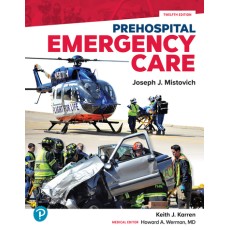Prehospital Emergency Care 12th Edition -Paperback
Prehospital Emergency Care is the most complete resource for EMT training. It will help you move seamlessly from assessment to diagnosis to emergency care for life-threatening conditions and injuries.
By offering a foundation of pathophysiology, Mistovich conveys not just the “what” but also the “why” of signs, symptoms, and recommended care. In doing so, he will help you confidently assess and interpret findings, deliver excellent emergency care, and prepare for success on course and credentialing exams.
The 12th Edition meets 2021 National EMS Education Standards. It reflects the latest and best emergency medical services in the US, including the American Heart Association's 2020 Guidelines for CPR and ECC, as well as the American Stroke Association's latest Prehospital/EMS Care Stroke Guidelines.
PART 1: PREPARATORY AND PUBLIC HEALTH
- Emergency Medical Service Systems, Research, and Public Health
- Workforce Safety and Wellness of the EMT
- Medical, Legal, and Ethical Issues
- Documentation
- Communication
- Lifting and Moving Patients
PART 2: ANATOMY, PHYSIOLOGY, AND MEDICAL TERMINOLOGY
- Anatomy, Physiology, and Medical Terminology
PART 3: PATHOPHYSIOLOGY
- Pathophysiology
PART 4: LIFE SPAN DEVELOPMENT
- Life Span Development
PART 5: AIRWAY MANAGEMENT, RESPIRATION, VENTILATION, AND OXYGENATION
- Airway Management, Respiration, Ventilation, and Oxygenation
PART 6: ASSESSMENT
- Vital Signs, Monitoring Devices, and History Taking
- Scene Size-Up
- Patient Assessment
PART 7: GENERAL PHARMACOLOGY AND MEDICATION ADMINISTRATION
- General Pharmacology and Medication Administration
PART 8: SHOCK AND RESUSCITATION
- Shock and Resuscitation
PART 9: MEDICAL
- Respiratory Emergencies
- Cardiovascular Emergencies
- Altered Mental Status, Stroke, and Headache
- Seizures and Syncope
- Acute Diabetic Emergencies
- Allergic and Anaphylactic Reactions
- Toxicologic Emergencies and Infectious Diseases
- Abdominal, Hematologic, Gynecologic, Genitourinary, and Renal Emergencies
- Environmental Emergencies
- Submersion Incidents: Drowning and Diving Emergencies
- Vulnerable Populations: Psychiatric Emergencies and Psychosocial Issues
PART 10: TRAUMA
- Trauma Overview: The Trauma Patient and the Trauma System
- Bleeding and Soft Tissue Trauma
- Burns
- Musculoskeletal Trauma and Nontraumatic Fractures
- Head Trauma
- Spinal Injury and Spine Motion Restriction
- Eye, Face, and Neck Trauma
- Chest Trauma
- Abdominal and Genitourinary Trauma
- Multisystem Trauma and Trauma in Special Patient Populations
PART 11: SPECIAL PATIENT POPULATIONS
- Obstetrics and Neonatal Care
- Patients with Special Challenges
- The Combat Veteran
PART 12: EMS OPERATIONS
- Ambulance Operations and Air Medical Response
- Gaining Access and Patient Extrication
- Hazardous Materials
- Multiple-Casualty Incidents and Incident Management
- EMS Response to Terrorist Incidents and High Threat and Active Shooter Incidents
APPENDICES
- ALS-Assist Skills
- Advanced Airway Management
- Agricultural and Industrial Emergencies





